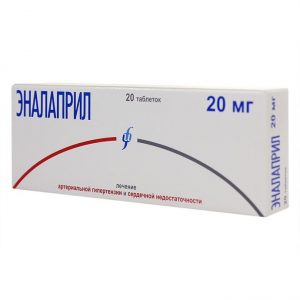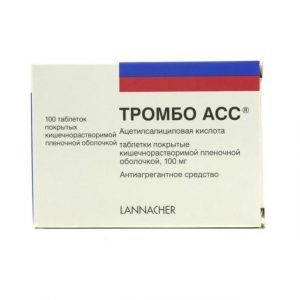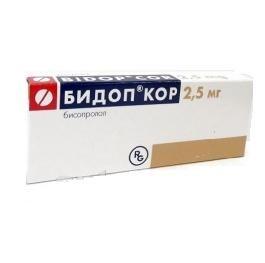Description
Latin name
CORONAL
Release form
film-coated tablets.
Packing
In a blister pack of 10 tablets. There are 3 blisters in the package.
Pharmacological action
Kornam is a blocker of peripheral postsynaptic A1 adrenoreceptors.
By blocking the A1-adrenergic receptors of the smooth muscles of the prostate gland and bladder neck, the drug helps to normalize urination in patients with benign prostatic hyperplasia.
Causes the expansion of arterioles and venules, reduces OPSS and venous return to the heart, resulting in decreased blood pressure. Reduces plasma renin activity, reduces myocardial oxygen demand, reduces heart rate at rest and during exercise. It has hypotensive, antiarrhythmic and antianginal effects.
The antihypertensive effect is associated with a decrease in minute blood volume, sympathetic stimulation of peripheral vessels, a decrease in the activity of the renin-angiotensin system (more important for patients with initial hypersecretion of renin), restoration of sensitivity in response to a decrease in blood pressure and effects on the central nervous system. With arterial hypertension, the hypotensive effect develops after 2-5 days, a stable effect – after 1-2 months.
Antianginal effect is due to a decrease in oxygen demand of the myocardium as a result of decreased heart rate and reduced contractility, lengthening of diastole, and improved myocardial perfusion. containing 2 -adrenoreceptors (pancreas, skeletal muscles, smooth muscles of peripheral arteries, bronchi and uterus) and carbohydrate metabolism, does not cause sodium ion retention in the body. When used in high doses (200 mg or more), it has a blocking effect on both subtypes of -Adrenoreceptors, mainly in the bronchi and smooth muscles of blood vessels.
Indications
– Arterial hypertension.
– CHD: prevention of angina attacks.
Contraindications
– Shock (including cardiogenic).
– Collapse.
– Pulmonary edema.
– Acute heart failure.
– Chronic heart failure in the decompensation stage.
– AV blockade II and III degree.
– Sinoatrial blockade.
– SSSU.
– Severe bradycardia.
– Angiospastic angina pectoris (Prinzmetal angina).
– Cardiomegaly (without signs of heart failure).
– Arterial hypotension (systolic blood pressure below 100 mmHg, especially with myocardial infarction).
– A history of bronchial asthma and chronic obstructive pulmonary disease.
– Concomitant use of MAO inhibitors (except for type B MAO inhibitors).
– Late stages of peripheral circulation disturbance.
– Raynaud’s disease.
– Pheochromocytoma (without the simultaneous use of alpha-blockers).
– Metabolic Acidosis.
– Age under 18 years of age (efficacy and safety not established).
– Hypersensitivity to the drug and other beta-blockers.
With caution, the drug should be prescribed in the following cases:
– Hepatic failure.
– Chronic renal failure.
– Myasthenia gravis.
– Thyrotoxicosis.
– Diabetes mellitus.
– 1st degree AV block.
– Psoriasis.
– Depression (including history).
– Elderly patients.
Use during pregnancy and lactation
Use of Coronal during pregnancy and lactation (breastfeeding) is possible if the intended benefit to the mother outweighs the risk of side effects in the fetus or baby.
When taking bisoprolol during pregnancy, the fetus may experience intrauterine growth retardation, hypoglycemia, and bradycardia.
Composition
1 coated tablet contains: bisoprolol fumarate 10 mg.
Excipients: microcrystalline cellulose, corn starch, sodium lauryl sulfate, anhydrous colloidal silicon dioxide, magnesium stearate.
Shell composition: hypromellose, macrogol 400, titanium dioxide (E171), red iron oxide (E172).
Dosage and administration
The drug is prescribed orally 2.5-5 mg 1 time / day. If necessary, increase the dose to 10 mg 1 time / day. The maximum daily dose is 20 mg.
Tablets should be taken in the morning on an empty stomach, without chewing.
Application for impaired renal function: or liver. In patients with impaired renal function with creatinine clearance less than 20 ml / min or with severe impaired liver function, the maximum daily dose is 10 mg.
Side effects
The frequency of occurrence of side effects is defined as follows: very often ( 1/10), often ( 1/100 and <1/10), infrequently ( 1/1000 and <1/100), rarely ( 1/10 000 and <1/1000), very rarely (<1/10 000, including individual messages). From the side of the central nervous system and peripheral nervous system: infrequently – increased fatigue, asthenia, dizziness, headache, drowsiness or insomnia, depression rarely – hallucinations, nightmares, convulsions. From the sensory organs: rarely – impaired vision, decreased secretion of lacrimal fluid, dry and sore eyes, hearing impairment is very rare – conjunctivitis. From the cardiovascular system: very often – sinus bradycardia often – decrease in blood pressure, manifestation of angiospasm (increased disturbance of peripheral circulation, cooling of the lower extremities, paresthesia) infrequently – impaired AV conduction, orthostatic hypotension, decompensation of chronic heart failure, peripheral edema. From the digestive system: often – dry mucous membranes of the oral cavity, nausea, vomiting, diarrhea, constipation rarely – hepatitis, increased activity of hepatic transaminases. From the respiratory system: infrequently – difficulty breathing when prescribed in high doses (loss of selectivity) and / or in predisposed patients – laryngo- and bronchospasm rarely – nasal congestion, allergic rhinitis. From the endocrine system: rarely – hyperglycemia (in patients with type 2 diabetes), hypoglycemia (in patients, receiving insulin). Allergic reactions: rarely – skin itching, rash, urticaria. Dermatological reactions: rarely – increased sweating, skin hyperemia very rarely – psoriasis-like skin reactions, exacerbation of psoriasis symptoms, alopecia. From the musculoskeletal system: infrequently – muscle weakness, cramps in the calf muscles, arthralgia. From the hemopoietic system: in some cases – thrombocytopenia, agranulocytosis. Other: rarely – hypertriglyceridemia very rarely – impaired potency, rarely – withdrawal syndrome (increased angina attacks, increased blood pressure). Drug Interaction Allergens used for immunotherapy or allergen extracts for skin tests increase the risk of severe systemic allergic reactions or anaphylaxis in patients receiving bisoprolol. When co-administered with Coronal, iodine-containing X-ray contrast agents for intravenous administration increase the risk of anaphylactic reactions. Phenytoin for co-administration with coronal, drugs for inhalation general anesthesia (hydrocarbon derivatives) increase the severity of cardio-depressive action and the likelihood of reducing blood pressure. Coronal alters the effectiveness of insulin and oral hypoglycemic medicines while masking symptoms of developing hypoglycemia (tachycardia, increased blood pressure). When co-administered, coronal decreases the clearance of lidocaine and xanthines (except for dipillin) and increases their plasma concentrations, especially in patients with initially elevated theophylline clearance under the influence of smoking. NSAIDs (due to the delay of sodium ions and blockade of the synthesis of prostaglandin by the kidneys), ACS and estrogens (due to the delay of sodium ions) attenuate the hypotensive effect of the Coronal. Cardiac glycosides, methyldopa, coronal concomitant administration, reserpine and guanfacine, slow calcium channel blockers (verapamil, diltiazem), amiodarone, and other antiarrhythmic drugs increase the risk of developing or worsening bradycardia, AV blockade, cardiac arrest, and heart failure. When used with Coronal, nifedipine can significantly reduce blood pressure. When co-administered with the Coronal, diuretics, clonidine, sympatholytics, hydralazine and other antihypertensive drugs can lead to an excessive decrease in blood pressure. Coronal prolongs the action of non-depolarizing muscle relaxants and the anticoagulant effect of coumarins. When used with Coronal, tricyclic and tetracyclic antidepressants, antipsychotic drugs (neuroleptics), ethanol, sedatives and sleeping pills increase CNS depression. It is not recommended that Coronal be administered concomitantly with MAO inhibitors due to a significant increase in antihypertensive activity, with a break of at least 14 days between the administration of MAO and Coronal inhibitors. When co-administered with Coronal, non-hydrogenated ergot alkaloids, ergotamine, increase the risk of peripheral circulation disorders. When co-administered with Coronal, sulfasalazine increases plasma concentrations of bisoprolol. When co-administered with Coronal, rifampicin shortens the elimination half-life of bisoprolol. Overdose Symptoms: arrhythmia, ventricular extrasystole, severe bradycardia, AV blockade, decreased blood pressure, heart failure, cyanosis of finger nails or palms, shortness of breath, bronchospasm, dizziness. Treatment: It is necessary to wash the stomach and appoint adsorbing drugs. Carry out symptomatic therapy: at the developed AV blockade – in / in introduction of 1-2 mg of atropine, epinephrine (epinephrine (adrenaline) or staging of a temporary pacemaker with ventricular extrasystole – in / in lidocaine (drugs I A class are not used) at reduction of blood pressure the patient should be in the position of Trendelenburg in the absence of symptoms of pulmonary edema – in / in plasma-replacement solutions, with inefficiency – the introduction of epinephrine (adrenaline), dopamine, dobutamine (to maintain chrono- and inotropic action and eliminate marked BP) in heart failure – cardiac glycosides, diuretics, glucagon in convulsions – in / in diazepam with bronchospasm – beta 2-adrenomimetics inhalation. Storage conditions The drug should be stored in a dark place at a temperature of 15 ° to 25 ° C. Expiration 2 years. Deystvuyuschee substances bisoprolol tablet dosage form Formulation




